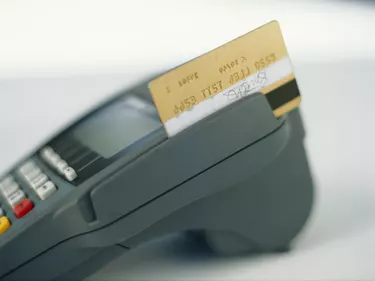
While hooking a credit card to a laptop machine may seem complicated, they're designed to be connected with minimal fuss in only minutes. The computer acts as the credit card terminal and the machine that plugs in acts as the input and card reader. Credit card machines with three tracks can also read drivers license magnetic strips.
Types
Video of the Day
There are several different types of credit card terminals that can be plugged into a computer. One is a basic keypad and card reader with no display; it's usually light, portable and inexpensive. Read-only display terminals allow the customer to see what he's keyed in and the cost of his transaction, but he can't write on the display. Some larger credit card terminals have input displays that can record signatures so you don't have to have the customer sign a hard copy of the credit card receipt.
Video of the Day
Connection and Software
Connect the credit card machine to the laptop by plugging the USB cable attached to the card reader into an open USB port on the laptop. Check the documentation that came with the unit to determine what type of USB port it needs to function. Most models draw power from the USB connection and don't need to be plugged into an outlet. Some credit card machines that work with laptops are plug and play, so they're installed and work with the system as soon as you connect the two devices. Others require software installation before they'll work. If your credit card machine comes with a disc, place it in the computer and follow the prompts to install the software before processing a transaction.
Security
When shopping for a machine, look for one that offers both SSL security and is PCI compliant. SSL security encrypts the information being sent from the credit card terminal to the processor so that an unauthorized source can't read and save it. PCI compliance means that you adhere to the safety procedures and protocols as set forth by the credit card companies whose payments your process. Lists of approved PIN-entry devices and payment software are available from the PCI Security Standards Council (see links in Resources).
Merchant Accounts
If you don't have software on your computer to accept payments, set up a merchant account to manage your payments. Services like PayPal, Authorize.net and PayLeap both check to make sure the transaction is valid and manage the money being transferred from the customer's account to yours. Connect the credit card machine to your merchant account from the software that runs the card reader. The service you choose must be PCI compliant -- using a third-party payment processor doesn't mean that you don't have to be PCI compliant.
Internet Connection
Credit card machines connected to a laptop require an Internet connection to process transactions in real time. The speed of your connection determines how long it takes the transaction to process. USBSwiper says the average processing time is two to four minutes, but that it can vary based on the connection in your area. In order to ensure PCI Compliance, always enable password protection on your wireless router and use one that encrypts data.
Computer Compatibility and Safety
One problem you can have when hooking a credit card machine to your laptop is an operating system and software conflict. Not all credit card machines use software designed for the most recent operating systems. It's important to use software created to work with your computer; if the two aren't compatible, then the credit card machine may not work or you may lose functions.
To keep customers' data safe, your PC should be protected from outside threats. Install an anti-virus program on the computer and run it regularly to detect and remove threats. Enable your software firewall -- you can use both a router firewall and a computer firewall at the same time.